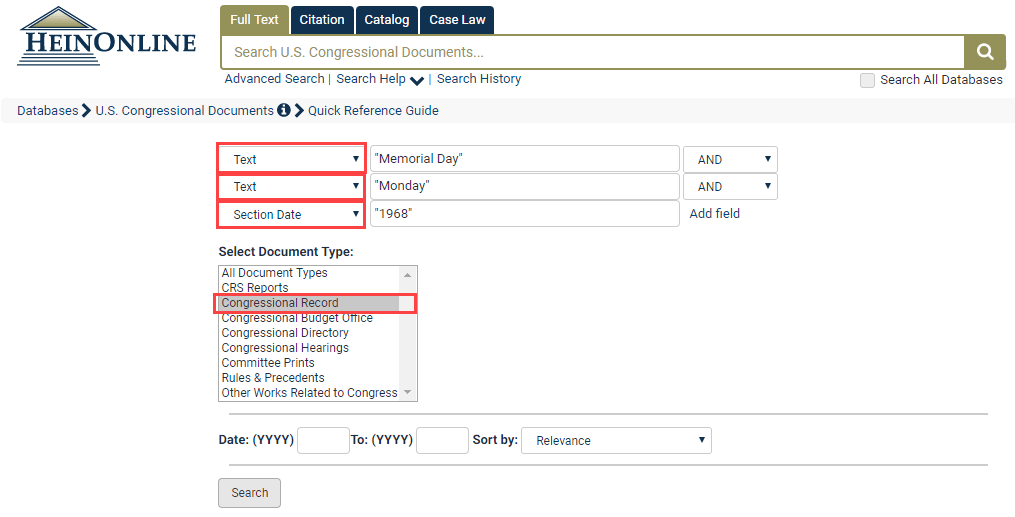As previous generations have done before us, this Memorial Day we honor those who have given their lives in military service to the United States. In this post, we will revisit the surprisingly controversial history of Memorial Day and use HeinOnline to examine its institution as a U.S. federal holiday.
Before We Get Started:
Don’t miss out! Make sure you have the databases we’ll be mentioning in this post. Follow the links below to start a trial today.
The Origins of Memorial Day
Memorial Day is a federal holiday dedicated to the remembrance of fallen United States soldiers. Observed annually on the last Monday in May, the holiday is recognized through the closing of the federal government as well as most schools and businesses across the country. Many American citizens commemorate Memorial Day by visiting cemeteries or memorials to decorate military graves with flowers, notes, or the American flag.
Previously known as “Decoration Day,” Memorial Day is controversial in its origins –so much so that a Center for Memorial Day Research has been established at Columbus State University in Columbus, Georgia. While most agree that the origins of the holiday can be traced back to the Civil War, the official year and birthplace of the tradition are both hotly debated.
Numerous claims have been made as to the origin of Memorial Day. Some refer to President Abraham Lincoln as the founder of the holiday, following his cemetery dedication at Gettysburg in 1863. Others argue that Memorial Day stems from Charleston, South Carolina when, in 1865, a group of recently freed African-American men properly reburied and celebrated 257 Union soldiers. Columbus, Georgia lays claim to the origin as well, following the decoration of graves by a group of women there in 1866. The issue was further complicated when President Lyndon B. Johnson officially designated Waterloo, New York as the birthplace of the holiday in 1966.
Regardless of its origin, the first formal request for an annual observation of “Decoration Day” came from General John A. Logan on May 5, 1868. Many northern states adopted the holiday in the same year, with the first Northern Memorial Day ultimately observed on May 30, 1868.
Designating the U.S. Federal Holiday
The name “Decoration Day” gradually changed to “Memorial Day,” with the first usage of the latter appearing in 1882. Toward the end of the 19th century, Decoration Day ceremonies were being held on May 30th each year all over the U.S. The name “Memorial Day” became more common after World War II, and at that point, the holiday was expanded to include those who have died in all American wars.
After a joint resolution from Congress in 1950, President Harry S. Truman proclaimed each May 30th as a day for nationwide prayers for peace. Users can find President Truman’s original proclamation in HeinOnline’s U.S. Presidential Library.
From the database home page, type “harry s. truman” AND “may 30” into the main search bar to bring up a list of related results. The first result will redirect the user to Harry S. Truman’s proclamation in Title 3 of the Code of Federal Regulations.

Though nationally celebrated, Memorial Day did not become a federal holiday until 1971. In 1968, Congress passed the Uniform Monday Holiday Act which changed the dates of several holidays, including Memorial Day, to designated Mondays throughout the year in order to increase the number of three-day weekends. The act was not signed into federal law until January 1, 1971 after initial dissension in Congress. Even today, the act has continued to cause heated debate between Memorial Day traditionalists and those interested in other activities on their day off.
Users can read first-hand about the dissension in Congress regarding this act in HeinOnline’s U.S. Congressional Documents database. From the home page, click on the Advanced Search link hyperlinked in blue underneath the main search bar. In the first search bar, next to the word Text, type “Memorial Day.” In the second search bar, change the drop-down search option to Text, as well, and type “Monday.” In the third search bar, change the drop-down to Section Date, and enter “1968.” Users can then change the document type to “Congressional Record” in the Select Document Type listings.
The first listing in the subsequent results will direct users to a transcript of the Congressional debate, shedding light on both sides of the controversy.

Critics of the act have claimed that the change in date ultimately caused Memorial Day to lose its meaning. To many, Memorial Day now represents the beginning of summer rather than the solemn remembrance of U.S. soldiers. In response, Congress passed the National Moment of Remembrance Act, requesting that American citizens pause for one minute at 3:00 p.m. in united national reflection each Memorial Day.
To view this act in HeinOnline, navigate to the U.S. Statutes at Large database. Select the Popular Name browsing option and filter the search by the letter “N” to view the National Moment of Remembrance Act in the list of results.

Perhaps you will spend this Memorial Day honoring the fallen by participating in traditional cemetery decoration. Maybe you will spend quality time outdoors with your family and friends, soaking in the summer sun. Either way, HeinOnline hopes you enjoy your chosen celebration of the freedoms for which our soldiers bravely fought.
Keep up with HeinOnline’s coverage of current and historical events. Subscribe to the HeinOnline Blog to receive notifications when new blogs are posted.
Don’t forget to connect with us on our social media platforms: Facebook, Twitter, Instagram and YouTube.



